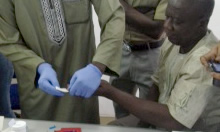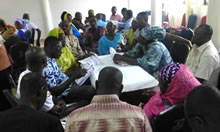Anemia in Ghana
Anemia is a critical health problem in Ghana, affecting 66 percent of children under five and 42 percent of women of reproductive age (GSS, GHS, and ICF International 2014). It has significant adverse effects on the country’s health and economic development. High rates of anemia contribute to increased morbidity and mortality among infants, young children, and women (SPRING and GHS 2016). Although the contribution of the specific causes of anemia have not been quantified in Ghana, endemic malaria is likely a large contributor, along with parasitic infections and intestinal worms, iron deficiency, and vitamin A deficiency (SPRING and GHS 2016).
SPRING’s Approach to Reducing Anemia in Ghana
The USAID's Multi-Sectoral Nutrition Strategy 2014–2025 (2014) highlights the need for an integrated, multi-sectoral approach to reduce anemia. Since 2014, USAID’s SPRING project has been engaged in preventing stunting and anemia in 15 districts in Ghana, targeting the Northern and Upper East regions. Our work in Ghana focuses on women and children within the first 1,000 days of life— the period from a woman’s pregnancy to the child’s second birthday.
This brief describes SPRING’s investments in three areas of anemia programming in Ghana: 1) strengthening coordination and collaboration for anemia, 2) capacity building, and 3) community-level engagement. Within each section on these areas, we also highlight our experiences and the lessons learned through two core principles that guided our anemia reduction efforts in Ghana: creating linkages and building a foundation for sustainability. In each section, we also highlight current and future challenges and suggest potential ways to manage them.
Creating Linkages: SPRING measured the success of our process by assessing how our activities created or reinforced connections and communication channels among diverse stakeholders from multiple sectors, or levels of government, or at various points of contact with the community.
Building a Foundation for Sustainability: SPRING is a time-limited project working in the Northern and Upper East regions of Ghana. When designing our activities, one of our core guiding principles was continuity, to ensure that the work initiated by us will to be continued by other existing institutional structures or organizations.
Strengthening Coordination and Collaboration for Anemia
Anemia is a complex condition with many causes, which cannot be addressed by one sector alone. Anemia reduction requires multiple sectors (e.g., health, agriculture, water, governance, and gender) to work together toward a common goal. A strong policy environment that prioritizes a multi-sectoral response to anemia prevalence, as well as effective coordination and collaboration across sectors, is key to a successful anemia reduction program. In Ghana, SPRING has raised the profile of anemia among stakeholders and supported coordination and collaboration for anemia programming by working closely with government agencies and departments at the national, regional, and district levels.
Conducting a Landscape Analysis
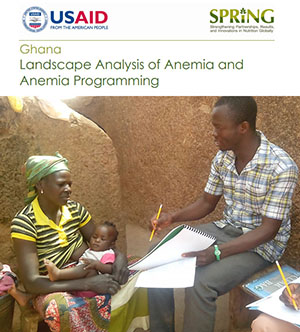
At the request of the Ghana Health Service (GHS), SPRING conducted a landscape analysis describing the anemia situation in Ghana, to better understand the factors contributing to anemia, track the progress of anemia-related programs, and identify and reconcile problems and gaps. The landscape analysis highlighted the need to update GHS’s 2003 Integrated Anaemia Control Strategy (GHS 2003) to reflect and address the latest understanding of anemia, ongoing programs, and gaps in implementation. The landscape analysis also identified opportunities to strengthen the antenatal care (ANC) system with an integrated package of services for pregnant women (iron-folic acid [IFA] supplementation, intermittent preventive treatment of malaria [IPTp], and deworming) and emphasized the need to determine the feasibility of implementing evidence-based interventions such as delayed cord clamping, intermittent IFA supplementation for menstruating women, and point-of-use fortification for young children. The landscape analysis helped increase the urgency for addressing the anemia situation in Ghana and spurred the GHS to request the development of a comprehensive anemia training package for health workers and community health volunteers (CHVs). A comprehensive picture of anemia is incomplete without a measurement of the levels of biomarkers, which is carried out through micronutrient surveys that are representative of regional and national levels of micronutrient deficiency. Carrying out a micronutrient survey every five years in Ghana should give national planners further information about the interventions needed.
Read Ghana: Landscape Analysis of Anemia and Anemia Programming for more on the findings of the landscape analysis.
Supporting the Micronutrient Task Team
At the national level, SPRING has continued to raise the profile on anemia by supporting the efforts of the Micronutrient Task Team (MTT), under the direction of the GHS. The MTT is a multi-stakeholder group spearheaded by the Nutrition Department of the GHS, with additional representation from government departments responsible for malaria and helminth control, reproductive health, and water and sanitation, and other partners. We also participated in the Technical Working Group for anemia, a subcommittee of the MTT comprised of GHS personnel and technical experts. The MTT is responsible for reviewing micronutrient-related activities in Ghana, ensuring that they align with national agendas related to anemia and other micronutrient deficiencies.

The MTT provided a platform for GHS and partners to advance the anemia agenda. We worked closely with the MTT to bring ideas and strategies for reducing anemia forward for discussion and action. With the MTT’s leadership, SPRING has given urgency to and contributed to the national dialogue on anemia and design of programmatic approaches. The MTT provided extensive comments on our landscape analysis document, for example, and provided input into our concept paper on intermittent IFA supplementation for adolescents in the Northern region. Our presentation of proposals and reports in the MTT meetings brought regional- and district-level anemia activities to national attention and contributed to future policy development.
Implementing the District Assessment Tool for Anemia
SPRING has developed a Microsoft Excel-based District Assessment Tool for Anemia (DATA) to help countries with strengthening anemia programming at the district level. The aim of the tool is to increase awareness about the multifaceted nature of anemia, better understand what drives anemia in a given context, and help districts plan and prioritize actions using local data to address both the immediate and underlying causes of anemia. SPRING piloted DATA in Kumbungu district, in the Northern region, in 2015 in collaboration with the GHS Regional Health Directorate and the Kumbungu District Assembly. The pilot brought together government staff from the health, water, agriculture, and education sectors to discuss the causes of anemia, analyze data, and prioritize anemia actions. The pilot showed that DATA increased awareness of anemia as a problem that extends well beyond the health sector and requires a multisectoral response. As one outcome of this awareness, the Ghana Education Service and GHS decided to synchronize their visits to schools under the school-based deworming program, instead of the previous approach of separate visits by each sector. In addition, the action plan devised by the agriculture sector involved changes to the training module for farmers on irrigation, to now include measures to prevent the occurrence of standing water, a major environmental factor leading to malaria and anemia.
The DATA process allowed participants from different sectors to recognize the opportunities for collaboration with other sectors, or with other agencies within their sector when developing a joint action plan to control and prevent anemia. SPRING refined DATA based on input from the pilot and developed a package of materials for use in a two-day facilitated workshop. Subsequently, we led a training-of-trainers (TOT) workshop in preparation for rollout of the tool in seven districts in the Northern region. The trainers then carried out a DATA workshop in their districts with the support of our field staff.
Read Ghana: Field Testing of the District Assessment Tool for Anemia (DATA) for more information on the results of the DATA pilot in Kumbungu district.
Our District Assessment Tool for Anemia (DATA) page hosts the Excel tool as well as the workshop facilitation materials.
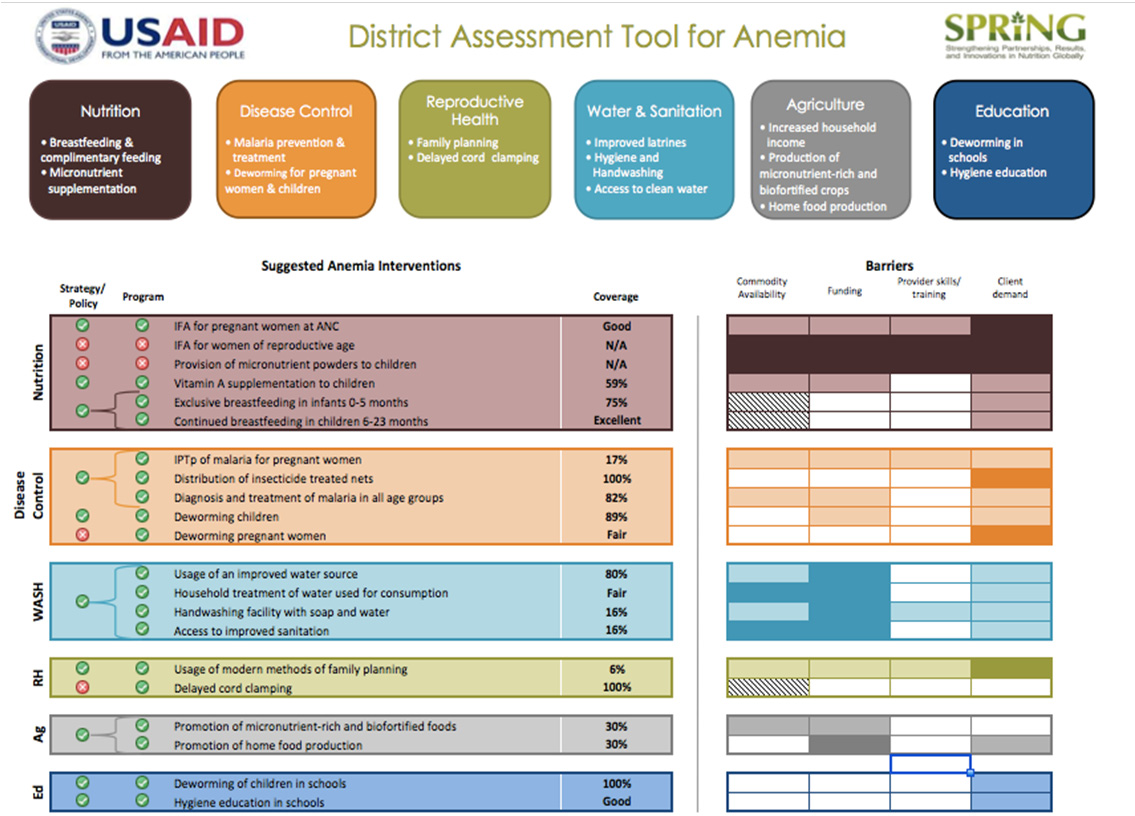
The long-term usefulness of DATA will be reflected in its application by district managers for their planning activities. Since DATA is designed to be used by a multi-sectoral group, we need to document the frequency and manner of its use in District Assemblies of the Northern and Upper East regions, where it has been introduced. The tool requires minimal resources, so the only risk to its sustainability would come from the tool not being used. USAID and its implementing partners in Ghana can promote the uptake of DATA by the districts and also call upon the cadre of SPRING-trained health workers to provide refresher instruction on its implementation.
Lessons Learned
Creating Linkages: MTT is a national policy–focused platform, and provided a critical platform for the GHS and implementing partners to exchange programmatic updates and discuss emerging evidence on anemia. This enabled strengthening of the national anemia response by promoting coordination and collaboration among members and avoiding duplication of work. MTT also served as a channel for conveying emerging evidence, to guide policy modifications or implementation in the field and ensure that the needs of the regionally based agencies were represented at the national level. This approach fostered a cross-pollination of ideas among the members, with enhanced opportunities for collaboration and linkages.
At the district level, the implementation of DATA established the groundwork for strengthening collaborative implementation and partnership among different sectors. DATA enabled sectors to understand how they can work together to address anemia, through increased integration of activities (e.g., the health and agriculture sectors working together for malaria control by eliminating standing water in agriculture fields) and sharing monitoring data to assess progress.
Building a Foundation for Sustainability: At the national level, the MTT provided an effective platform for creating dialogue and driving action on anemia. National platforms such as the MTT are critical for sharing evidence-based best practices and ensuring a coordinated response to anemia in-country. For example, we were able to promote learning from regional anemia activities to a national audience, including policymakers, for potential scale-up. At the district level, we learned through the process of piloting and then implementing DATA that bringing key district sectors together to discuss and prioritize anemia activities significantly increased their understanding of the multifaceted nature of anemia. Scale-up of DATA will lead to a broader assessment of the district-level anemia situation and better integration of anemia activities into district plans. Using existing national and district organizational structures and data collection platforms not only strengthened capacity, but also led to buy-in for the scale-up of DATA.
Capacity Building
Addressing anemia requires that health workers and CHVs have the capacity to effectively diagnose, control, and prevent anemia. SPRING supported service provider capacity building by developing the training curriculum for health workers on prevention and treatment of anemia at both the facility and community levels and led trainings in anemia management.
Increasing Health Worker Capacity to Measure Anemia
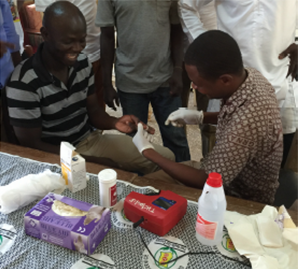
As per current GHS protocols, all pregnant women in Ghana reporting for ANC services have their hemoglobin level measured at registration, 28 weeks, and 36 weeks, to allow for early identification and management of anemia. Diagnosis of anemia requires a blood test to measure hemoglobin levels. The lack of adequate facilities for blood testing had hampered the efforts of the GHS to effectively manage anemia. At health facilities in the Northern and Upper East regions, USAID distributed HemoCue® devices, a diagnostic tool reliable for testing anemia in low-resource settings. At the request of the GHS, SPRING developed a training curriculum and hosted a HemoCue TOT workshop to provide laboratory technicians, nutrition officers, public health and staff nurses, and disease control officers with the necessary skills to use the device for accurate measurement of hemoglobin. These trained personnel serve as regional resource persons who can train district health facility staff in the correct use of the device. We trained 529 health staff from the Northern and Upper East regions in the appropriate use of the HemoCue device. We also trained 70 health facility staff from the two regions as master trainers able to conduct future trainings. The primary obstacle to effective use of HemoCue remains the continuous supply of microcuvettes. The microcuvettes are easily procured, though they are expensive. USAID has supported the GHS by supplying microcuvettes, but that is not a long-term solution. Sustainability will be ensured when hemoglobin testing with HemoCue is added to the list of tests that is reimbursable under the Ghana National Insurance Scheme.
Read the training module Facilitator’s Guide to Training Health Workers in Ghana to Measure Haemoglobin and Assess Anaemia with the HemoCue® Hb 301 Device for more information.
Training Health Workers to Address Anemia
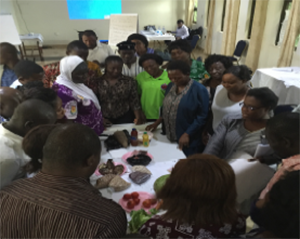
Anemia can be prevented, but when it does occur, it must be effectively addressed. This requires ensuring health workers are equipped with an updated understanding of the determinants of anemia and knowledge of existing guidelines and strategies for preventing and controlling anemia. One of the findings of SPRING’s landscape analysis was the need to improve health worker capacity to address anemia. At the request of the GHS, we developed the Health Worker Training Manual for Anemia Control in Ghana, with two aims—(1) to provide health workers with the knowledge and skills to provide anemia services at health facilities and (2) to build the capacity of health workers as trainers to facilitate anemia trainings for CHVs, who work with community members to increase awareness on anemia.
In addition to information on causes of anemia and interventions to address it, the content of the training includes nutrition materials from GHS’s community-based infant and young child feeding (C-IYCF) training and our module on diagnosing anemia using a HemoCue device. We developed the training package in consultation with the MTT, and trained a subgroup of the MTT as master trainers for the anemia curriculum. This group then trained regional trainers in the Northern and Upper East regions, who carried out trainings for facility-based health staff and community-based CHV.
This cascade training approach both ensured a link between the national and the district levels and grew the pool of trained personnel. Overall, we trained 20 health staff at the regional level and 70 at the district level as master trainers to conduct cascade training. The cascade training involved 459 health workers and 291 CHVs across 15 districts.
Some of the major difficulties in providing appropriate anemia prevention and treatment, highlighted by the participants in these trainings, include, but are not limited to: inadequate access to Hb testing and, consequently, mistreatment of anemia and its complications; availability of appropriate IFA formulation at the point of care; and lack of mentoring and supportive supervision after training. Systemic impediments to effective implementation that were mentioned include a lack of financial resources and limited human capacity to deliver services in the community.
Although district-level officials have limited influence over the supply chain at the regional and national levels, they could use SPRING’s quality improvement (QI) approach in their health facilities and communities to identify and solve service delivery challenges. The QI approach helps team members work together to identify a service delivery problem by reviewing available data and information and identifying the root causes of the problem. Subsequently, they select a solution-focused intervention that is within the control of the facility or the community, then implement it, and monitor progress using indicators. The QI approach is empowering because its problem-solving process is driven by the people who desire a solution.
Lessons Learned
Creating Linkages: SPRING created explicit linkages between the national and district levels in our anemia management training, where the cascade of training from national to district involved trainers from the higher level conducting training for personnel at a lower level. The district health staff trained CHVs, to link districts to the community. Linkages in personnel are complemented by the linkages in the training curriculum for anemia management, where we used materials from different training contexts (e.g., GHS’s C-IYCF and SPRING’s HemoCue training module served as source materials). We found that use of previously established material both serves as a refresher training and reinforces the key messages from the various trainings in which staff have participated.
Building a Foundation for Sustainability: SPRING training workshops in the Northern and Upper East regions have built a cadre of trained regional- and district-level staff capable of diagnosing and managing anemia, and who can carry out quality improvement processes in facilities and communities. The staff trained in quality improvement can use the analytical approach from the training to find solutions to other delivery challenges outside of nutrition. These staff will also serve as expert trainers during scale-up of the trainings to other regions of Ghana.
Community-Level Engagement
SPRING’s approach to anemia program implementation also engaged communities to adopt positive nutrition behaviors to prevent and control anemia. This engagement contributed to sustainable service delivery by stimulating demand for facility-based services, which we also worked to strengthen.
Mother-to-Mother Support Groups
Mother-to-mother support groups (MTMSGs) provides a platform for caregivers to learn from their peers about adopting better nutrition practices. Each MTMSG had at least 30 members, made up of pregnant or lactating women, caregivers of children under two years of age, and at least two grandmothers from the community. SPRING has created 150 MTMSGs across the 15 districts where we work, with the aim to allow CHVs to help mothers adopt ideal infant and young child feeding and care practices. We used this platform to also engage the community about prevention of anemia. We provided CHVs with an MTMSG guide on carrying out group and individual discussions on anemia. We customized the guide to the Northern region context, using simple language, pictorial depiction of terms, and local-language terms related to anemia. SPRING provided guidance on how to use the guide in the training that the CHVs received from the health workers as part of the training package on anemia.
Read the forthcoming brief on nutrition in Ghana for more information on our MTMSGs available soon here.
Improving Community WASH Efforts
Water, sanitation, and hygiene (WASH) interventions play a major role in preventing the spread of infectious diseases—one of the causes of anemia. SPRING’s WASH 1,000 strategy promoted the adoption of four evidence-based household behaviors that allowed communities to achieve a “clean household status.” The behaviors included: (1) washing hands with soap (at “tippy tap” stations) at appropriate times; (2) safely disposing of adult and child feces in a latrine; (3) creating clean play spaces that separate children from environmental contaminants (soil, animal feces, human feces), especially for children under two years of age; and (4) disinfecting drinking water (most commonly through boiling) for children six months to two years of age. SPRING has supported the National Sanitation Strategy, which promotes a community-led total sanitation (CLTS) process toward a goal of open defecation free (ODF) communities. We promoted messages through mass media and community groups, such as mother-to-mother and father-to-father support groups, farmer groups, school health clubs, and environmental health and community development units. Communities have embraced WASH 1,000 key behaviors as a way to prevent malnutrition. SPRING has implemented the WASH 1,000 approach in 105 communities, constructing 1,298 household toilets and 453 tippy taps. In addition, we provided training to 545 local leaders and 714 water and sanitation management team members, who help in their communities’ efforts towards reaching ODF status.
Read our forthcoming brief Engaging Community Members to Adopt Effective WASH Practices for Nutrition for more information on our WASH 1,000 programming in Ghana available soon here.
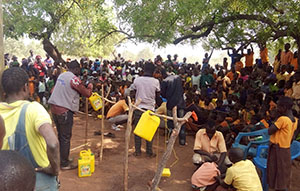
SPRING’s community-level activities demonstrate how service delivery can connect with and amplify efforts undertaken by health facilities. However, the main hurdle to their sustainability remains the motivation and support given to the CHVs. In the future, community activities should be organized in a way that takes the time constraints of CHVs into consideration and does not overburden them.
Creating Linkages: Community engagement by health workers and CHVs through WASH 1,000 and MTMSGs created better relationships with community members and a greater understanding among health workers about the barriers to implementing these interventions at the community level.
Building a Foundation for Sustainability: Community platforms for reaching households, such as MTMSGs and school health clubs, served as foundations for engagement with communities on anemia reduction. We learned that these groups can be effective in amplifying the messages that health facilities relay to the population. The use of peer groups leads to increased adoption of health behaviors.
Building on SPRING’s Legacy to Maintain Momentum for Anemia
SPRING has provided a strong foundation for anemia reduction efforts, which can be taken forward by the Government of Ghana and its implementing partners, including other USAID projects.
Creating linkages between national-level policymakers and regional- and district-level implementers through a collaborative training program on anemia also leads to sustainable action. Through the implementation of the DATA, district-level planners improve their knowledge of the national policy guidance as well as priorities for intervention activities in the district and communities. DATA also creates linkages and opportunities for collaboration among different sectors such as health, agriculture, water, and education at the district level, when they decide together on the priorities in anemia interventions for each sector. Improvements at the health facility level foster internal and inclusive participation by service providers and encourage increased interaction with clients. To improve outcomes in anemia, not only do services at the facilities need to be of a high quality, but communities also need to believe that they will receive timely services of a high quality. For this reason, activities at the facility level need to be linked with community engagement. For example, training caregivers in dietary counseling at the child welfare clinic in the health facility needs to be followed up with community efforts to increase caregivers’ IYCF behavior adoption in 1,000-day households. Mothers need support in implementing the dietary advice given at the health facility; having assistance from a community worker in implementing this advice in the familiar environment of her home will encourage adoption and also amplify the benefits of the advice. Future anemia reduction efforts should continue to build on the linkages created through implementation of the anemia training program, DATA, and the quality improvement process.
SPRING works at both the national and district levels to foster an enabling policy environment and political commitment to provide a strong foundation for sustainability of anemia prevention and control activities in Ghana. This approach has resulted in greater awareness of anemia at all levels. The MTT and its Technical Working Group developed the anemia training manual, and have adopted it as an official guidance document of the GHS. The manual is being used for training health workers outside of our implementation areas. Our training on reducing anemia led to the creation of a cadre of master trainers at the national level, who have gone on to train regional- and district-level trainers. The MTT provided a national platform to showcase our work at the regional level and provided evidence and learning that will support the national scale-up of these approaches. The GHS has played a leadership role in developing the anemia training package that SPRING supported. GHS will now use the training package in other regions of Ghana.
SPRING’s legacy has galvanized stakeholders at the national, regional, and district levels to raise the profile on anemia and take actions to prevent and control it. We supported platforms that provided critical leadership to advance the nutrition agenda, contributed to the national dialogue on emerging evidence, brought together staff from multiple sectors for joint action planning, and provided tools for capacity building at the facility and community levels. This combined approach resulted in a coordinated and strengthened response to anemia in Ghana and ultimately in improved services for women and children in SPRING districts, and beyond.
Download the full brief above.
References
Ghana Health Service (GHS). 2003. National Anaemia Control Strategy. Accra: GHS Nutrition Unit.
Ghana Statistical Service (GSS), Ghana Health Service (GHS), and ICF Macro. 2014. Ghana Demographic and Health Survey 2013. Accra: GSS, GHS, and ICF Macro.
SPRING and Ghana Health Service. 2016. Ghana: Landscape Analysis of Anemia and Anemia Programming. Arlington, VA: Strengthening Partnerships, Results, and Innovations in Nutrition Globally (SPRING) project.
U.S. Agency for International Development (USAID). 2014. Multi-Sectoral Nutrition Strategy 2014–2025. Washington, DC: USAID. Available at https://www.usaid.gov/sites/default/files/documents/1867/USAID_Nutrition....
